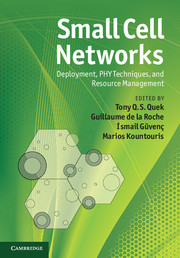Book contents
- Frontmatter
- Contents
- List of contributors
- Foreword by David Chambers
- Acknowledgments
- Acronyms
- 1 Small cell networks overview
- 2 Fundamentals of access control in femtocells
- 3 Coverage analysis using the Poisson point process model
- 4 Interference modeling for cognitive femtocells
- 5 Multiple antenna techniques in small cell networks
- 6 Physical layer techniques for cognitive femtocells
- 7 Femtocell coverage optimization
- 8 Random matrix methods for cooperation in small cell networks
- 9 Mobility in small cell networks
- 10 Cognitive radio resource management in autonomous femtocell networks
- 11 Decentralized reinforcement learning techniques for interference management in heterogeneous networks
- 12 Resource allocation optimization in heterogeneous wireless networks
- 13 New strategies for femto-macro cellular interference control
- 14 Femtocell interference control in standardization
- 15 Spectrum assignment and fairness in femtocell networks
- 16 Self-organization and interference avoidance for LTE femtocells
- Index
- References
3 - Coverage analysis using the Poisson point process model
Published online by Cambridge University Press: 05 May 2013
- Frontmatter
- Contents
- List of contributors
- Foreword by David Chambers
- Acknowledgments
- Acronyms
- 1 Small cell networks overview
- 2 Fundamentals of access control in femtocells
- 3 Coverage analysis using the Poisson point process model
- 4 Interference modeling for cognitive femtocells
- 5 Multiple antenna techniques in small cell networks
- 6 Physical layer techniques for cognitive femtocells
- 7 Femtocell coverage optimization
- 8 Random matrix methods for cooperation in small cell networks
- 9 Mobility in small cell networks
- 10 Cognitive radio resource management in autonomous femtocell networks
- 11 Decentralized reinforcement learning techniques for interference management in heterogeneous networks
- 12 Resource allocation optimization in heterogeneous wireless networks
- 13 New strategies for femto-macro cellular interference control
- 14 Femtocell interference control in standardization
- 15 Spectrum assignment and fairness in femtocell networks
- 16 Self-organization and interference avoidance for LTE femtocells
- Index
- References
Summary
Introduction
The rapid rate of increase in data traffic means that future wireless networks will have to support a large number of users with high data rates. A promising way to achieve this is by spectrum reuse through the deployment of cells with small range, such that the same time-frequency resources may be reused simultaneously in multiple cells. At the same time, the traditional coverage requirement for wireless users (supporting a modest rate at cell-edge users) is most economically met with cells having large range, i.e., the traditional macrocellular architecture. Thus the wireless cellular networks of the future are likely to be heterogeneous, i.e., have one or more tiers of small cells overlaid on the macrocellular tier.
We consider the problem of network design from the point of view of a service provider considering the deployment of a network in a certain region. The primary metric we shall focus on is the coverage on the downlink: namely, the probability that a user at an arbitrary location in the deployed network has coverage. Later, we shall briefly discuss the distribution of the maximum rate that such a user could support from one of the base stations (BSs).
When we talk of the service provider designing a network to satisfy a certain coverage criterion, we mean the choice of deployment parameters for such a network, including:
Number of tiers of the network
Densities of the BSs in the tiers
Transmit powers of the BSs in the tiers.
- Type
- Chapter
- Information
- Small Cell NetworksDeployment, PHY Techniques, and Resource Management, pp. 44 - 81Publisher: Cambridge University PressPrint publication year: 2013



